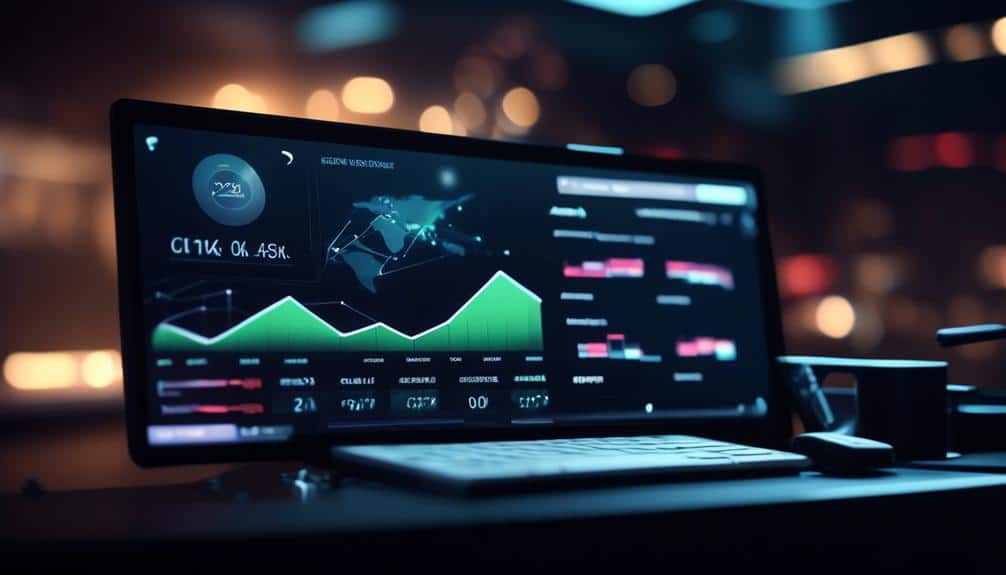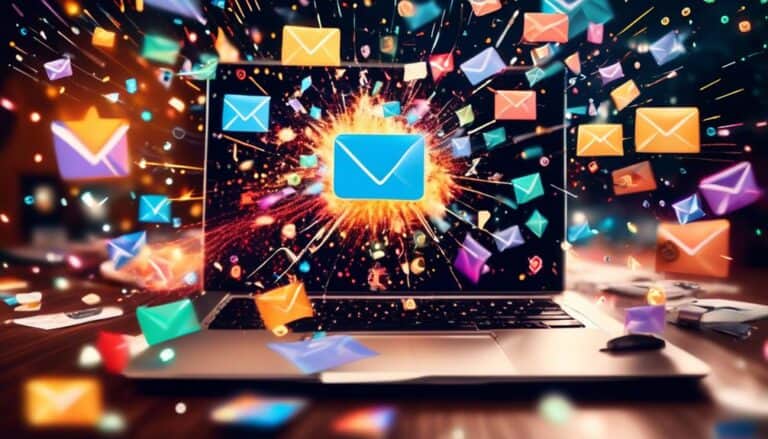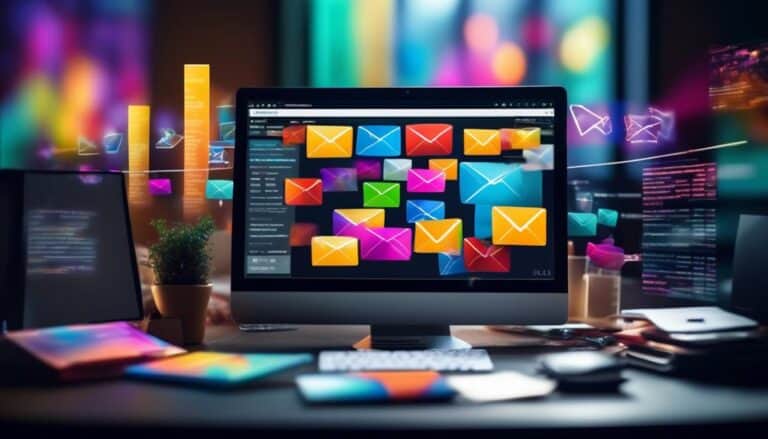Exclusive Secrets: Unlock the Power of Automated Email Sequences Now or Never
Are you ready to unlock the power of automated email sequences and take your marketing strategy to new heights?
Just imagine these sequences as a well-oiled machine, seamlessly guiding your audience through a carefully crafted journey, nurturing leads, and driving conversions.
But here's the catch – if you don't act now, you might miss out on the incredible opportunities that await you in the world of automated email sequences.
So, let's dive in and discover the exclusive secrets that will revolutionize the way you engage with your audience, boost your sales, and skyrocket your business success.
Key Takeaways
- Implementing automated email sequences increases engagement and conversions by utilizing segmentation strategies.
- Email sequence analytics provide valuable insights for optimization, allowing data-driven decisions to maximize impact.
- Personalization and segmentation in email sequences enhance the likelihood of conversions and personalized experiences.
- Leveraging advanced techniques and tools, such as behavioral triggers and A/B testing, can further optimize email sequences for better targeting and results.
The Benefits of Automated Email Sequences

Unlock the full potential of your email marketing strategy with the undeniable benefits of automated email sequences. By implementing segmentation strategies and leveraging email sequence analytics, you can take your email campaigns to new heights of effectiveness and impact.
Segmentation strategies allow you to divide your email list into specific groups based on demographics, interests, or behaviors. This enables you to send targeted and personalized content to each segment, increasing engagement and conversions.
With automated email sequences, you can set up a series of emails that are automatically triggered based on subscriber actions or predefined time intervals. This ensures that your audience receives relevant and timely messages that resonate with their specific needs and interests.
The power of email sequence analytics can't be overstated. By tracking and analyzing data such as open rates, click-through rates, and conversions, you can gain valuable insights into the performance of your campaigns. This allows you to make data-driven decisions and optimize your email sequences for maximum impact. You can identify which emails are generating the highest engagement and conversions, and refine your strategy accordingly.
How to Set Up Your Automated Email Sequences
To set up your automated email sequences, follow these simple steps for maximum effectiveness and impact:
- Choose a reliable email marketing platform:
- Look for a platform that offers features specifically designed for setting up email automation.
- Ensure that the platform integrates seamlessly with your existing systems and tools.
- Define your goals and target audience:
- Clearly identify the purpose of your email sequences, whether it's nurturing leads, onboarding new customers, or promoting a product.
- Understand your target audience's needs, pain points, and preferences to tailor your email content accordingly.
- Plan your email sequence flow:
- Map out the journey you want your subscribers to take, from the first email to the final conversion.
- Determine the number of emails in your sequence and the time intervals between each email.
- Create compelling and relevant content:
- Craft engaging subject lines to entice recipients to open your emails.
- Provide valuable and personalized content that addresses your subscribers' challenges and offers solutions.
- Test and optimize your email sequences:
- A/B test different elements such as subject lines, email copy, and call-to-action buttons to identify what resonates best with your audience.
- Monitor key metrics like open rates, click-through rates, and conversions to refine and improve your email sequences.
Best Practices for Creating Effective Email Sequences

Now that you have set up your automated email sequences, let's explore the best practices for creating effective email sequences.
To ensure that your emails are targeted and relevant, segmentation strategies are crucial. By dividing your audience into smaller groups based on demographics, interests, or purchase history, you can tailor your messages to meet their specific needs. This personalization won't only increase engagement but also drive higher conversion rates.
Another important best practice is A/B testing. This technique allows you to experiment with different elements of your emails, such as subject lines, call-to-action buttons, or content layout, to determine which version performs better. By testing and analyzing the results, you can optimize your email sequences for maximum impact.
In addition to segmentation and A/B testing, it's essential to maintain consistency in your email sequences. Ensure that your messages align with your brand's voice, style, and values. Consistency builds trust and reinforces your brand identity.
Lastly, prioritize providing value to your subscribers. Offer valuable content, exclusive discounts, or useful resources that address their pain points and demonstrate your expertise. By consistently delivering value, you'll nurture strong relationships with your audience and increase their loyalty.
Segmenting Your Audience for Personalized Email Sequences
Segmenting your audience is a vital step in creating personalized email sequences that resonate with your subscribers. By implementing advanced segmentation techniques, you can increase engagement through personalized emails.
Here's how:
- Demographic Segmentation:
- Divide your audience based on age, gender, location, or any other relevant demographic information. This allows you to tailor your email content to specific groups, ensuring it speaks directly to their needs and interests.
- Use dynamic content to customize your emails based on demographic data. This way, each subscriber receives content that's most relevant to them, leading to higher open rates and click-through rates.
- Behavioral Segmentation:
- Analyze subscriber behavior such as website visits, previous purchases, or email engagement levels. This information helps you create targeted email campaigns that align with their interests and preferences.
- Develop triggered email sequences based on specific actions, such as abandoned cart reminders or post-purchase follow-ups. These automated emails provide a personalized experience for each subscriber, increasing the likelihood of conversion.
Crafting Attention-Grabbing Subject Lines for Email Sequences

Craft attention-grabbing subject lines for your email sequences to increase open rates and engage your subscribers from the moment they see your email in their inbox. Engaging copywriting is crucial in capturing your audience's attention and enticing them to click open your emails.
To increase open rates, it's essential to craft subject lines that are concise, persuasive, and strategic.
When crafting your subject lines, keep in mind that clarity and relevance are key. Your subscribers receive numerous emails daily, so it's important to stand out and make your subject line compelling. Use language that creates a sense of urgency or curiosity, encouraging them to open your email right away.
Personalization is another effective strategy to engage your subscribers. By including their name or referencing their previous interactions with your brand, you can make them feel special and valued. This personal touch will increase the chances of them opening your email and engaging with your content.
Testing different subject lines is also crucial for increasing open rates. A/B testing allows you to compare the performance of different subject lines and determine which ones resonate best with your audience. Analyzing the results and fine-tuning your subject lines accordingly will help you optimize your email sequences for maximum engagement.
Crafting attention-grabbing subject lines is a powerful way to increase open rates and engage your subscribers. By using engaging copywriting, personalization, and testing, you can enhance the effectiveness of your email sequences and drive better results for your business.
The Power of Behavioral Triggers in Email Sequences
By leveraging behavioral triggers in your email sequences, you can effectively engage and nurture your subscribers based on their actions and preferences. This powerful technique allows you to tailor your communication to each individual, enhancing their experience and increasing the likelihood of conversions.
Here's how you can utilize behavioral triggers to maximize the impact of your email sequences:
- Leveraging customer data for personalized email triggers:
- Analyze your subscribers' behavior and preferences to identify key triggers.
- Utilize segmentation to create targeted email sequences based on specific actions or interests.
- The psychology behind effective behavioral triggers:
- Understand your audience's motivations and desires to craft compelling messages.
- Use scarcity and urgency to create a sense of FOMO (fear of missing out) and drive action.
Analyzing and Optimizing Your Email Sequences for Maximum Results

To maximize the results of your email sequences, it's crucial to analyze and optimize your approach.
Start by segmenting your audience for better targeting, ensuring that your messages are reaching the right people at the right time.
Test different subject lines to capture attention and increase open rates.
Finally, personalize your email content to establish a connection with your recipients and drive engagement.
Segmenting for Better Targeting
Optimize your email sequences for maximum results by analyzing and segmenting your audience for better targeting. By segmenting your audience, you can tailor your emails to their specific needs and interests, improving engagement and increasing conversions.
Here's how you can effectively segment your audience:
- Demographic segmentation: Divide your audience based on demographic factors such as age, gender, location, and occupation. This allows you to send targeted emails that resonate with their unique characteristics.
- Behavioral segmentation: Analyze your audience's past interactions with your emails, website, and products. Identify patterns and segment your audience based on their behaviors, such as purchase history, browsing activity, or engagement level. This enables you to send personalized and relevant content that drives conversions.
Testing Subject Lines
Unlock the full potential of your email sequences by conducting thorough testing and optimization of your subject lines. A/B testing subject lines is a crucial step in analyzing email open rates and maximizing the effectiveness of your email sequences. By testing different subject lines and analyzing the results, you can determine which subject lines resonate best with your audience and lead to higher open rates. This allows you to refine your subject lines and create more compelling and engaging emails. To help you get started, here is a table that outlines the steps you can take to test and analyze your subject lines:
| Step | Description | Action |
|---|---|---|
| 1 | Choose a sample size | Select a subset of your subscriber list for the test |
| 2 | Create variations | Create two or more different subject lines for your emails |
| 3 | Measure and analyze open rates | Track and compare the open rates of each variation |
Personalizing Email Content
By tailoring your email content to the unique preferences and needs of your audience, you can amplify the impact of your email sequences and drive maximum results. Personalization techniques for email content are essential to engage your audience and make them feel valued.
Here are two strategies for increasing engagement through personalized emails:
- Segment your audience: Divide your email list into smaller segments based on demographics, behavior, or interests. This allows you to create targeted content that resonates with each group, increasing the likelihood of engagement.
- Use dynamic content: Utilize dynamic content to customize your emails based on individual preferences or past interactions. By showing your audience that you understand their needs and interests, you can create a more personalized and engaging experience.
Implementing these techniques won't only enhance your email sequences but also strengthen your relationship with your audience, leading to better results.
Integrating Automation Tools for Seamless Email Sequences

Now is the time to take your email sequences to the next level by integrating automation tools.
By doing so, you'll unlock a multitude of benefits, including increased efficiency, improved personalization, and higher engagement rates.
With seamless workflow integration, you'll be able to streamline your email marketing efforts and deliver targeted, timely messages to your audience, maximizing the impact of your campaigns.
Email Automation Benefits
Maximize the efficiency and effectiveness of your email marketing campaigns by seamlessly integrating automation tools for a streamlined and personalized email sequence experience.
- Improved efficiency
Reduce manual tasks and save time by automating repetitive processes
Schedule emails in advance, allowing you to focus on other important tasks
- Increased customer engagement
Send targeted and personalized emails based on customer behavior and preferences
Trigger emails based on specific actions, such as abandoned carts or completed purchases
Seamless Workflow Integration
To seamlessly integrate automation tools for a streamlined and personalized email sequence experience, leverage the power of workflow integration. By implementing automation in your workflow, you can optimize your email sequences for maximum efficiency. This allows you to deliver the right message at the right time, ensuring that your audience receives a personalized and engaging experience.
Take a look at the table below to see how workflow integration can enhance your email sequences:
| Benefits of Workflow Integration | How it Improves Email Sequences |
|---|---|
| Increased workflow efficiency | Ensures timely delivery of emails |
| Streamlined process | Reduces manual tasks |
| Enhanced personalization | Tailors emails to individual needs |
| Improved segmentation and targeting | Delivers relevant content |
| Better analytics and tracking | Measures the success of campaigns |
Case Studies: Real-Life Examples of Successful Email Sequences
In real-life examples of successful email sequences, businesses have utilized automated campaigns to drive engagement and conversions. Here are some case studies that demonstrate the power of automated email sequences:
- Case Study 1: Measuring the ROI
- A clothing retailer implemented an automated email sequence to target customers who'd abandoned their carts. By sending a series of personalized emails with product recommendations and limited-time offers, they were able to recover 30% of abandoned carts, resulting in a 20% increase in revenue.
- An online course provider used an automated email sequence to nurture leads and convert them into paying customers. By delivering valuable content and offering exclusive discounts, they achieved an impressive ROI of 400% within three months.
- Case Study 2: Key Metrics to Track and Analyze
- A software company implemented an onboarding email sequence to guide new users through the product features and benefits. By tracking the open rates and click-through rates of each email, they were able to identify areas for improvement and optimize the sequence, resulting in a 50% increase in product adoption.
- A nonprofit organization utilized an email sequence to engage donors and encourage recurring donations. By tracking donation conversion rates and donor retention rates, they were able to identify their most effective messaging and optimize their email sequence, resulting in a 25% increase in recurring donations.
Future Trends and Innovations in Automated Email Sequences

The future of automated email sequences holds exciting possibilities for businesses to enhance engagement and drive conversions. As technology continues to advance, future trends in automated email sequences will be heavily influenced by leveraging AI (Artificial Intelligence). AI-powered email sequences will enable businesses to deliver more personalized and targeted content to their audience, resulting in higher open rates and click-through rates.
Here is a glimpse of some future trends and innovations in automated email sequences:
| Trend | Description | Benefits |
|---|---|---|
| Dynamic Content Personalization | Tailoring email content based on individual preferences and behaviors | Increased engagement and conversion rates |
| Predictive Analytics | Using data and machine learning algorithms to predict customer behavior | Improved segmentation and targeting |
| Interactive Emails | Including interactive elements like polls, quizzes, and surveys in emails | Enhanced user experience and engagement |
| Chatbots Integration | Integrating chatbots with email sequences for real-time customer interaction | Improved customer support and satisfaction |
Frequently Asked Questions
Can You Provide Step-By-Step Instructions on How to Create an Email Sequence Using a Specific Email Automation Tool?
To create an email sequence using a specific automation tool, follow these step-by-step instructions. First, choose the tool that best fits your needs. Then, set up your sequence, using best practices for optimization. It's now or never to unlock the power of automated email sequences!
How Long Should an Automated Email Sequence Be?
For optimal results, your automated email sequence should be tailored to your audience's needs and preferences. By utilizing personalization techniques, you can create a strategic sequence that serves your subscribers effectively, regardless of its duration.
Are There Any Legal Considerations or Regulations to Keep in Mind When Using Automated Email Sequences?
When using automated email sequences, it's important to be aware of legal considerations and regulations. Make sure to follow guidelines regarding consent, unsubscribing, and data protection to ensure compliance and build trust with your audience.
What Are Some Common Mistakes to Avoid When Crafting Subject Lines for Email Sequences?
When crafting subject lines for email sequences, common mistakes to avoid include being vague, using overly promotional language, and not personalizing the subject line. Follow best practices by being concise, relevant, and intriguing to increase open rates.
Can You Provide Tips on How to Effectively Analyze and Interpret the Data From Your Email Sequences to Optimize Their Performance?
To effectively analyze and interpret the data from your email sequences, start by tracking key metrics like open rates and click-through rates. Use this data to identify patterns and trends, then optimize your sequences by making adjustments based on what's working best.
Conclusion
Now is the time to unlock the power of automated email sequences. With their numerous benefits, including increased efficiency and personalization, setting up and optimizing your sequences is essential for maximum results.
By segmenting your audience, crafting attention-grabbing subject lines, and integrating automation tools, you can create effective and seamless email sequences.
Real-life case studies showcase the success of this strategy, and future trends and innovations promise even more potential.
Don't miss out on this opportunity to revolutionize your email marketing. Act now or never.








